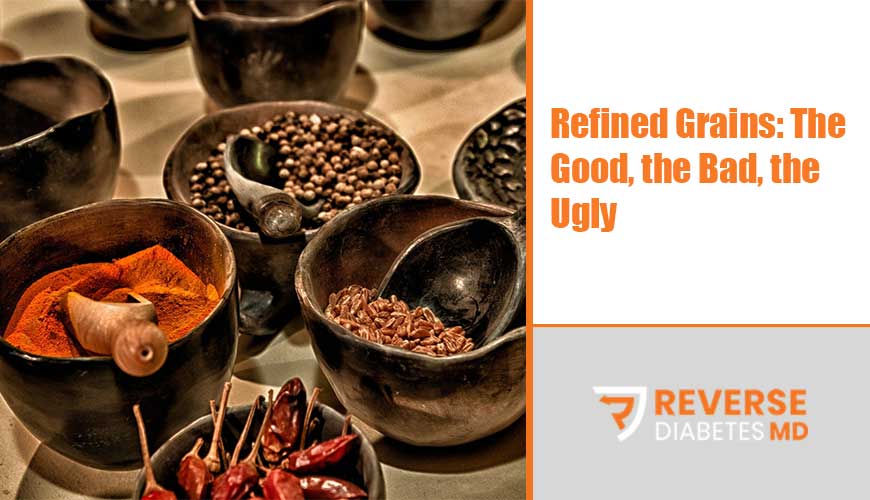Important Points:
- whole grains
- refined grains
- Western dietary pattern
- diabetes
- obesity
Refined Grains: The Good, the Bad, the Ugly
Flour is all around us and a temptation at every meal. Breakfast toast, bagels, cereal, and pancakes fill our tables. Lunch revolves around sandwiches, wraps, pasta and pizza. Refined grains have been vilified as one of the leadings causes of ill health. Is there any truth to this? Should we toss all refined grain products off our tables? We will have an in-depth look at the good, the bad, and the ugly of refined flour to give you a better understanding of the goodies on your plate.
What are Refined Grains?
Refined grain is the term used to refer to grains that are not whole, because they are missing one or more of their three key parts (bran, germ, or endosperm). White flour and white rice are refined grains, for instance, because both have had their bran and germ removed, leaving only the endosperm. Refining a grain removes about a quarter of the protein in a grain and half to two thirds or more of a score of nutrients, leaving the grain a mere shadow of its original self.
Further refining includes mixing, bleaching, and brominating; additionally, thiamin, riboflavin, niacin, and iron are often added back in to nutritionally enrich the product. Because the added nutrients represent a fraction of the nutrients removed, refined grains are considered nutritionally inferior to whole grains. However, for some grains the removal of fiber coupled with fine grinding results in a slightly higher availability of grain energy for use by the body.
Grain refining led to disastrous and widespread nutritional problems, like the deficiency diseases pelagra and beri-beri. In response, many governments recommended or required that refined grains be “enriched.”
The Good
The federal government’s 2010 Dietary Guidelines for Americans recommend that half your daily grain intake be from high-fiber whole-grain sources, foods like brown rice, oatmeal and whole-wheat bread. Nutritionists often exhort people to choose whole grains over refined ones whenever they can.
But according to one leading nutrition researcher, Julie Miller Jones, a professor emeritus at St. Catherine University, we shouldn’t be so eager to throw out refined grains altogether. Refined grains do have some benefits — namely, nutrients added to refined flours.
Since folic acid was added to bread, cereal and other grains in 1999, the rate of newborns with neural tube defects — a known consequence of folic acid deficiency — has decreased 46%. Additionally, important nutrients like copper and iron are more easily absorbed when eaten with refined grains. Whole grains are healthy because they’re so high in fiber, which Americans don’t get enough of, but that fiber also fast-tracks food through the digestive system, absorbing nutrients along the way.
The Bad
As our national appetite for flour has inched up, so has the incidence of diet-related ills, such as obesity, heart disease and diabetes. Coincidence? Many nutrition experts don’t think so. When they weigh the evidence linking food choices and disease, they see the white, dusty fingerprints of flour everywhere.
Flour started out as an ingenious fix to a vexing problem. Grass seeds were plentiful, but the tough outer shell (the husk) made the seeds difficult to chew and digest. Early humans outsmarted the seeds by grinding them between stones, crushing the outer layers to get at the goodness inside. The result — a coarse powder — was the first whole-grain flour.
The downside was spoilage. Crushing the germ released its oils, which quickly turned rancid when exposed to air. With the advent of industrial milling in the late 1800s, machines began filtering out the germ and pulverized the remaining endosperm into a fine, white powder that lasted on the shelf for months. And so all-purpose white flour was born — along with a host of health problems.
Beneath their rigid architecture, whole-kernel grains conceal an array of vitamins, minerals, phytonutrients and fiber. But when machines pulverize kernels into flour, even whole-grain flour, what’s left behind is a starchy powder capable of wreaking havoc on the body.
The Ugly
Overconsuming flour can lead to a number of problems in the body, including:
- Food Allergies/Intolerances. Gluten intolerance is a term that has become synonymous with the current generation. Wheat is one of the biggest dietary triggers of food allergies and intolerances. While the exact reason is unclear, many experts blame the higher gluten content of modern wheat varieties
- Blood-Sugar Spikes. The difference between a whole-kernel grain and a processed grain all boils down to the glycemic index, which is how quickly the body turns food into fuel, or glucose. Foods made with wheat flour are particularly damaging. A carbohydrate in wheat, called amylopectin A, is more easily converted to blood sugar than just about any other carbohydrate. Two slices of bread made with whole-wheat flour raise blood sugar higher than six teaspoons of table sugar and higher than many candy bars.
- Food Cravings. One of the biggest changes in modern wheat is that it contains a modified form of gliadin, a protein found in wheat gluten. Gliadin releases a feel-good effect in the brain by morphing into a substance that crosses the blood-brain barrier and binds onto the brain’s opiate receptors and makes you want to eat more.
- Caloric Overload. A refined grain packs more calories than a whole-kernel grain because it is more concentrated, and foods that are high in grains also tend to be high in sugar and industrialized fats. These foods contribute largely to obesity and the diabetes epidemic.
- Metabolic Slowdown. Research shows that the body may shift nutrients into fat storage and away from muscle burning in the presence of high-glycemic-index foods. In 2004, Ludwig and his colleagues at Harvard conducted a study, published in the journal Lancet, in which they fed rats diets with identical nutrients, except for the type of starch. By the end of the study, rats in both groups weighed roughly the same, but those eating a high-glycemic diet had 71 percent more fat than the low-glycemic-index group.
- Inflammation. A diet high in grains stokes inflammation. When blood sugar spikes, glucose builds up in the blood significantly. When glucose drifts in the blood, it attaches itself to nearby proteins resulting in a chemical reaction called glycation, a pro-inflammatory process that plays a role in a host of inflammatory diseases.
- GI Disorders. Studies show that the lectins in grains inflame the lining of the gut and create fissures between cells. Also, when whole-kernel grains are refined, 80 percent of the fiber is lost, and gut health suffers. Additionally, fiber helps sweep the gut of debris and supports the body’s critically important elimination and detoxification processes, which also play a role in keeping high cholesterol and inflammation at bay.
- Acid-Alkaline Imbalance. The body has an elaborate system of checks and balances to keep its pH level at a steady 7.4. A diet high in acidic foods, such as grains, forces the body to pull calcium from the bones to keep things on an even keel. When researchers looked at how the diets of more than 500 women affected their bone density, they found that a diet high in refined grains, among other nutrient-poor foods, was linked to bone loss. A highly acidic diet also chips away at our cellular vitality and immunity in ways that can make us vulnerable to chronic disease. Grains are the only plant foods that generate acidic byproducts. Wheat, in particular, is among the most potent sources of sulfuric acid, a powerful substance that quickly overcomes the neutralizing effects of alkaline bases.
The Bottom Line….
Grains are not essential, and there is no nutrient in there that you can’t get from other foods.






